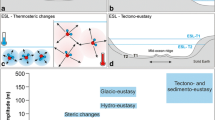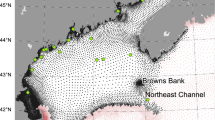Abstract
Methane in the East China Sea water was determined four times at a fixed vertical section along “PN line” consisting of 11–14 stations, in February 1993, October 1993, June 1994 and August 1994. The mean concentration of methane in the surface water was not significantly higher than that in the open ocean. The methane concentration below the pycnocline increased during the stratified period in summer to autumn and reached to 15 nmoles/l at most in October. The concentration of methane was fairly well correlated with AOU in the layer below the pycnocline in the stratified season. This means that methane in the bottom water has only a single source, which is expected to be anoxic sediments near the coast, and that the oxidation rate of methane in the water is extremely slow in the oxic water. The high methane observed in October completely disappeared in February, indicating that the methane was escaped to the atmosphere or transported to the pelagic ocean by the Kuroshio current. The East China Sea, therefore, is not a large direct and stationary source for the atmospheric methane, but may have some role as a source by supplying it sporadically to the atmosphere in early winter or indirectly from the surface of the pelagic ocean.
Similar content being viewed by others
References
Bange, H. W., U. H. Bartell, S. Rapsomankis and M. O. Andreae (1994): Methane in the Baltic and North Seas and a reassessment of the marine emissions of methane.Global Biogeochem. Cycles,8, 465–480.
Broecker, W. S., T.-H. Peng, G. Ostlund and M. Stuiver (1985): The distribution of bomb radiocarbon in the ocean.J. Geophys. Res.,90, 6953–6970.
Cicerone, R. J. and R. S. Oremland (1988): Biogeochemical aspects of atmospheric methane.Global Biogeochem. Cycles.,2, 299–327.
Conrad, R. and W. Seiler (1988): Methane and Hydrogen in seawater (Atlantic Ocean).Deep-Sea Res.,35, 1903–1917.
Cynar, F. J. and A. A. Yayanos (1992): The distribution of methane in the upper waters of the Southern California Bight.J. Geophys. Res.,97, 11269–11285.
de Angelis, M. A., M. D. Lilley, E. J. Olson and J. A. Baross (1993): Methane oxidation in deep-sea hydrothermal plumes of the Endeavour Segment of the Juan de Fuca Ridge.Deep-Sea Res.,40, 1169–1186.
Houghton, J. T., G. J. Jenkins and J. J. Ephraums (eds.) (1990): inClimate Change, The IPCC Scientific Assessment, Cambridge Univ. Press, Cambridge, 365 pp.
Jähne, B., G. Heinz and W. Dietrich (1987): Measurement of the diffusion coefficients of sparingly soluble gases in water.J. Geophys. Res.,92, 10767–10776.
Jones, R. D. and J. A. Amador (1993): Methane and carbon monoxide production, oxidation, and turnover times in the Caribbean Sea as influenced by the Orinoco River.J. Geophys. Res.,98, 2353–2359.
Kato, Y. and Y. Terunuma (1994): Recycling of biogenic materials in sediments from the East China Sea: results of MASFLEX porewater study.Proceedings of the 1994 Sapporo IGBP Symposium, pp. 238–245.
Lamontagne, R. A., J. W. Swinnerton, V. J. Linnenbom and W. D. Smith (1973): Methane concentrations in various marine environments.J. Geophys. Res.,78, 5317–5324.
Nakamura, T., Y. Nojiri, A. Otsuki and S. Hashimoto (1994): Methane concentration and its variation in seawater of highly eutrophic Tokyo Bay.Geochemistry,28, 47–57.
Nozaki, Y., V. Kasemupaya and H. Tsubota (1989): Mean residence time of the shelf water in the East China and the Yellow Seas determined by228Ra/226Ra measurements.Geophys. Res. Lett.,16, 1297–1300.
Saito, Y. and Z. Yang (1994): The Huanghe River: its water discharge, sediment discharge, and sediment budget.J. Sed. Soc. Japan,40, 7–17.
Tsunogai, S., S. Watanabe, J. Nakamura, T. Ono and T. Sato (1995): A preliminary study of carbon system in the East China Sea.xxx (to be submitted).
Wanninkhof, R. (1992): Relationship between wind speed and gas exchange over the ocean.J. Geophys. Res.,97, 7373–7382.
Watanabe, S., N. Higashitani, N. Tsurushima and S. Tsunogai (1994): Annual variation of methane in seawater in Funka Bay, Japan.J. Oceanogr.,50, 415–421.
Watanabe, S., N. Higashitani, N. Tsurushima and S. Tsunogai (1995): Methane in the western North Pacific.J. Oceanogr.,51, 39–60.
Watanabe, Y., K. Abe and M. Kusakabe (1994): Characteristics of the nutrients distribution in the East China Sea.Proceedings of the 1994 Sapporo IGBP Symposium, pp. 54–60.
Wiesenburg, D. A. and N. L. Guinasso, Jr. (1979): Equilibrium solubilities of methane, carbon monoxide, and hydrogen in water and sea water.J. Chem. Eng. Data,24, 356–360.
Author information
Authors and Affiliations
Rights and permissions
About this article
Cite this article
Tsurushima, N., Watanabe, S. & Tsunogai, S. Methane in the East China Sea water. J Oceanogr 52, 221–233 (1996). https://doi.org/10.1007/BF02235671
Received:
Revised:
Accepted:
Issue Date:
DOI: https://doi.org/10.1007/BF02235671




